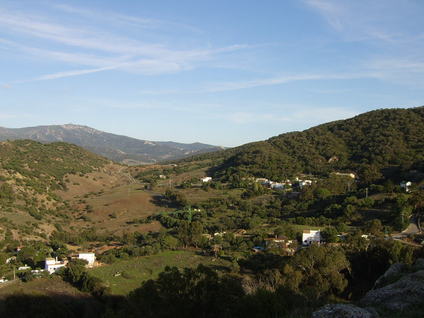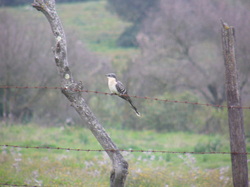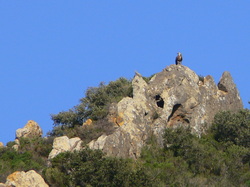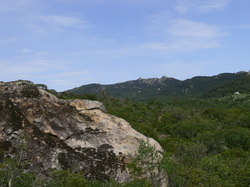




| Birding Cadiz Province |
|
 Entrance to the Molinos valley from Alcala The small village of Alcalá de los Gazules sits high on a small hill above the A381 behind which looms the wooded hills and crags of the Alcornocales. As the A 2304 skirts round the village a minor road (CA 6201) strikes off to the east. This takes you down the Molinos valley to the small hamlet, and that’s a generous use of the word, of Patrite which forms a lose cluster of houses at the valley. A plan, during the earlier years Franco’s dictatorship, to push the road all the way to Jimena (c17km through the park) was mercifully abandoned thus preserving the wild landscape. This was a mercy not just for the landscape, but also for those earmarked to build it as, like many roads of that era, it was to be built by forced labour using Republican prisoners. Although close by the village, a lip at the start of the valley means that once you’re a few hundred metres along it you can see scarcely any signs of civilization lending the place a surprisingly isolated feel.  Record shot of Great-spotted Cuckoo The start of the valley (a) is often a good spot to look out for Black-eared Wheatear as a pair usually breeds here. The road quickly drops down into the valley which then opens out as the road heads, arrow straight, towards Patrite. The telegraph wires here frequently provide a place for passing Bee-eaters to rest and for hunting Woodchat Shrike to use as a vantage point. In winter Woodchats may be replaced by Iberian Grey Shrike. About 3km along the road there’s a rough track (b), to your left, also bordered by telegraph wires which again provide perches for passing birds. With virtually no traffic, this is a better place to stop and look than the main road (although its hardly very busy). This is another site for breeding Black-eared Wheatear whilst I’ve also had passing Tawny Pipits and Great-spotted Cuckoos here. The whole valley seems to funnel migrants with Black and White Storks regularly passing over in good numbers and rarities like Rock Sparrow occasionally turning up. After just over a kilometre the track is closed off by gates and apparently private, but it’s worth exploring to this point as the stream, now shaded by trees, may attract small birds.  Griffons in the Molinos valley As with anywhere in Spain, the skies should be regularly scanned for raptors, but with a large roost of vultures further up the valley it’s not unusual to see a good sized flock of Griffon Vultures here although seeing them drop to the ground requires rather more luck. In late spring the birds often move out of roost at c10:00 AM. Any soaring flock should be checked carefully as Egyptian Vultures are regular enough to suggest that they might well breed not too far away. Booted and Short-toed Eagles too are frequently to be found here. Keeping you eyes closer to the ground shouldn’t be neglected either as the small stream lined with bushes that passes under the road near the campsite often attracts smaller birds; Melodious and Sardinian Warblers, Goldfinch and Serin. Look carefully at the latter during winter and on passage as Siskin also occur. The campsite makes a pleasant place to stay and has a resident Barn Owl. Little Owls are common and it’s hard to believe that the surrounding hills don’t harbour Eagle Owl. I’ve looked for them without luck, but have seen them in what appears less favourable habitat along the A381 near the village.  A Griffon Vulture sunning itself at the start of the valley At the far end of the road it degenerates into a rough track and finally a gated footpath (sendero) which takes you c1.5 km into the hills and to the last of several ruined molinos (water mills). After the Llanos de Libar (Grazalema) this walk is the one that most impresses my visitors. Following rain the rocky crags here often host Griffons which strike an impressive heraldic pose with wings open as the dry off in the sun. Fittingly, the rocks here may also have Blue Rock Thrush. Crested Lark has been the default lark thus far, but look carefully as I’ve had Thekla in rockier fields near the footpath (although they’re more frequent much further along the path). This, and other open areas, may also have Cirl Bunting. After skirting the crags on your left, the path climbs as it cuts diagonally across a thistle rich pasture towards the hills. As it snakes along the flank of the hill the path seems to reach a dead end, but continue onwards and where you seem to reach a blank rock wall the path suddenly takes a dogleg left and then right. This is a bit of a scramble but easily negotiable with care. Here the path squeezes (c) between jutting vertical rock strata to plunge back into what seems like a hidden valley. Although you may have had them already, the light woodland here is particularly good for various small passerines. Long-tailed Tits here are of the southern race A. c. irbii – named after the pioneering British ornithologist of the area, Lt-Colonel Irby. Firecrest are common as are both Bonelli’s Warbler and Iberian Chiffchaff. The latter has a song so distinct from the more familiar chiff-chaff-chiff-chaff of northern birds that it’s a surprise that the species so long languished as a ‘mere’ subspecies. A slightly drunken shief shief shief shief wee-wee-wee-wee-wee sweet sweet sweet it has a different cadence and a slightly Willow Warbler like trill.  The far end of the Molinos valley As you continue scan the distant (and not so distant) crags for roosting Griffons although you have as good a chance of seeing birds drifting low to see what you’re about. It’s not unusual to see 200-300 birds although upwards of 600 birds are possible. Check them very carefully as Spain’s second Ruppell’s Vulture occurred within the ‘parish’ making this as good a site as anywhere to look for this elusive visitor. Look out too for Spanish Ibex. Peregrines breed in the vicinity and, although rarer, Bonelli’s Eagle are regular. With Lesser Kestrels dominating in Alcala itself, these crags more often have Common Kestrel. Finally you reach, after a pleasant walk, a ruined mill (d) which makes a great picnicking spot. Technically, an old drover’s road continues all the way to Jimena (c15km) but a gate here marks the end of this sendero. You can continue over the stream and up towards the distant ‘forest road’ (Carrel Picacho-Piguera) just visible through the trees. The upper slopes here have Thekla Lark and are an even better viewpoint from which to search for raptors.
1 Comment
|
About me ...Hi I'm John Cantelo. I've been birding seriously since the 1960s when I met up with some like minded folks (all of us are still birding!) at Taunton's School in Southampton. I have lived in Kent , where I taught History and Sociology, since the late 1970s. In that time I've served on the committees of both my local RSPB group and the county ornithological society (KOS). I have also worked as a part-time field teacher for the RSPB at Dungeness. Having retired I now spend as much time as possible in Alcala de los Gazules in SW Spain. When I'm not birding I edit books for the Crossbill Guides series. CategoriesArchives
May 2023
|